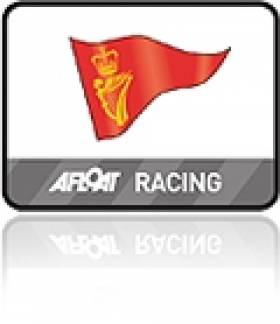Displaying items by tag: Pyewacket
The highlight of Royal Cork Yacht Club's junior sailing laying up supper conducted by Zoom at the weekend was the presentation of the Club's Pyewacket Trophy to the junior sailor who best represented the RCYC in 2020.
Ben O’Shaughnessy was awarded the top prize for his strong performance and second place overall in the AIB Optimist Nationals sailed on his home waters of Cork Harbour.
The trophy was originally presented by Roy Disney who was a long term member of the Royal Cork who donated a generous bursary to junior sailing in the Crosshaven club.
More on the laying up supper that attracted a turnout of over 150 sailors online here
Royal Cork Yacht Club Awards Laser Youth Sailor Seafra Guilfoyle
#royalcork – ISAF Youth Silver Medallist Séafra Guifoyle has won the Pyewacket Cup for the fourth time at Royal Cork Yacht Club writes Claire Bateman. Royal Cork's Guilfoyle has topped off a magnificent period of sailing and received the well deserved accolade of being awarded the Pyewacket Perpetual Cup. His silver medal achievement at the ISAF Youth world Championships at Tavira, Portugal in July was well recognised by the Munster club's adjudicating Committee. He showed true grit in producing a final race win in the series, his seventh top ten placing resulting in the silver medal, Ireland's second in as many years.
He had got off to a great start in the light wind series and scored an opening race win plus a fifth in race two and held this lead until the half way stage. "I nearly had gold but at the last minute Joel Rodriquez moved to finish fourth." This was enough for Rodriquez to take the gold and, to quote Séafra again, "I tried my best and am still thrilled with the result."
At Optimist level Séafra was National Champion in 2008 and 2009 and in 2011 he moved to a Laser 4.7 and became Class National Champion in that year.
In October 2001 the late Roy Disney, widely known American Sailing Enthusiast who had a home in West Cork, had strong ties with the Royal Cork Yacht Club, and participated in many Ford Cork Week Regattas, presented the club with the Pyewacket Perpetual Cup at a dinner in the club hosted by the then Admiral, Anthony O'Leary.
The Pyewacket Trophy is presented each year to the youth sailor, who in the opinion of the Adjudicating Committee , has achieved the best results overall in his or her class. and took place on November 14th at the highly successful and enjoyable Junior Laying Supper at the Royal Cork Yacht Club.
























